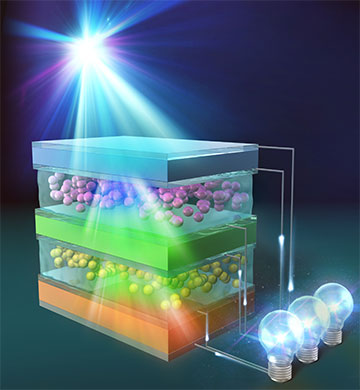
A multi-junction solar cell gets an efficiency boost from semiconductor layers bonded with an upconversion nanoparticle matrix. [Image: Courtesy of K. Tanabe, Kyoto University]
A research team from Kyoto University, Japan, tested a proof-of-concept design for enhancing solar-cell efficiency using a hydrogel with upconversion nanoparticles (UCNPs). In their multi-junction solar-cell prototype, a UCNP-studded hydrogel acts as an adhesive, bonding a thin top layer of silicon to a silicon solar-cell wafer. The UCNPs in the stacked structure convert long wavelengths of light that typically escape a solar cell’s capture into shorter wavelengths that the cell then can harvest and turn into energy (Appl. Phys. Lett., doi: 10.1063/5.0097427).
In demonstrations of their wavelength-converting semiconductor interface, team lead Katsuaki Tanabe and his colleagues observed significant photocurrent enhancement with laser irradiation. The researchers believe the wafer-bonding technology could be used in solar concentrators and for delivering precise wavelengths to individual components within optoelectronic devices.
Wafer-bonding technology
Traditionally, the layers in a multi-junction solar cell are fused to each other using a vapor-phase growth method. However, this method requires all materials in the solar cell to have matching lattice constants, as equal lattice constants create the optical bandgap needed for light absorption. A mismatch in lattice constants leads to thermal stress and lower energy output for the solar cell.
To overcome the limits of lattice-matching, Tanabe and his team looked to wafer-bonding technology—a method currently used to fabricate heterostructured devices like light-emitting diodes.
The researchers used a stacked multi-junction solar-cell design to test their new take on the wafer-bonding method. The proof-of-concept structure consisted of a thin silicon film acting as the upper subcell on top of a silicon solar-cell wafer. The layers were bonded with an adhesive hydrogel embedded with rare-earth-doped UCNPs.
In theory, the UCNP matrix would act as an optical upconverting interface, shortening the infrared wavelengths of light that pass through the upper subcell so they can be absorbed by the underlying solar-cell wafer.
Demonstrations with light
The research team tested the optical upconversion material by comparing the performance of silicon multi-junction solar cells manufactured with and without UCNPs in simulated sunshine.
They found that simulated sunlight carried too few photons at 980 nm, the excitation wavelength needed to launch the nanoparticles’ upconversion function. Therefore, they observed very little photocurrent gain by the cell with UNPCs. Another demonstration with 980-nm laser irradiation sufficiently triggered the upconversion function and resulted in significant photocurrent enhancement in the UNPC cell versus the reference cell.
Potential applications
The researchers concluded that wafer bonding with their UCNP matrix may not be practical for conventional multi-junction solar cells, but the technology could find use in solar-concentrator photovoltaics.
In addition to the silicon multi-junction solar cell, the researchers assembled several different stacked optical and electronic devices to show that their wafer-bonding technology could offer engineers more design freedom, allowing them to use a variety of semiconductor materials without sacrificing energy-conversion efficiency.
